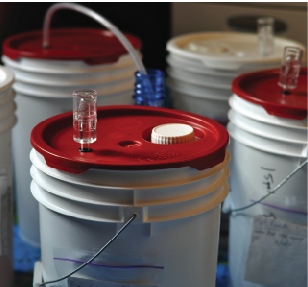Kaboom! Nobody likes an exploding carboy! “Fermentation happens,” as one of my professors at UC-Davis always used to say. Sounds like the perfect home winemaking meme to me (or t-shirt). As wine can produce quite a lot of carbon dioxide (CO2) gas, if that gas is trapped it can literally blow the top off your carboy, bucket, or barrel. Hence, we all love our fermentation locks. But when to use them? In general, anytime there’s too much CO2 being produced such that you can’t put a “hard top” on your container . . . but read on for some elucidation and detail.

When you’ve got a raging fermentation, like during days 3–6 or so when it’s really going, you can get away with covering the mouth of your vessel, whether a barrel, carboy, or a food-grade pail, with something like cheesecloth. A fine-weave cloth will do a great job of keeping the fruit flies away while the healthy amounts of CO2 coming off of your fermentation will protect against spoilage organisms.
However, when the fermentation is “ticking down” to its final degrees of sugar or malic acid and is no longer producing copious amounts of CO2 gas, it’s probably time to switch from the fabric stretched over the opening of your fermenter to a fermentation lock. Depending on how fast your fermentation is, that will likely be around day 8–10 of fermentation.
The water trapped in the “u-bend” of the fermentation lock lets the last of the gases escape yet doesn’t allow as much “dirty” air from the outside back in. Spoilage organisms like yeast and bacteria are circulating in the air all around us so while you still are off-gassing to some extent and aren’t ready to “hard-cap” your vessel, a fermentation lock is the way to go.
So there is no doubt that the most important time to use a fermentation lock is when your fermentation is still producing just a bit of CO2 and hasn’t quite stopped yet, as described. However, there’s no reason why you shouldn’t use a fermentation lock on a carboy before it starts taking off. It’ll do no harm and may do some good in stopping more microbes from potentially entering your vessel than if you just had it covered by fabric during a time when it’s still juice and hasn’t started producing CO2. Since it’s difficult to predict exactly when the fermentation process will begin, I find it’s better to be safe than sorry. My readers know that I’m all about excluding those spoilage microbes at all costs.
If the fermentation really takes off and you find your fermentation lock continually blowing itself off the top of your carboy due to high levels of gas being produced, it’s fine to switch to a fabric covering for a few days before replacing the fermentation lock when things calm down a bit. Then, when all fermentation is complete, it’s OK to “hard bung” your carboy, barrel, etc.
No matter the stage of your fermentation, I’m always a huge fan of using some kind of covering. Fruit flies and other household nuisances (even overly inquisitive pets) need to be excluded from sugary containers at all times.




